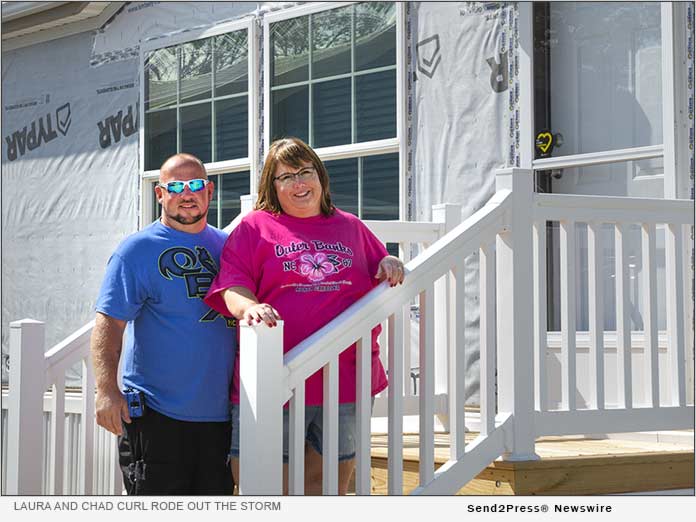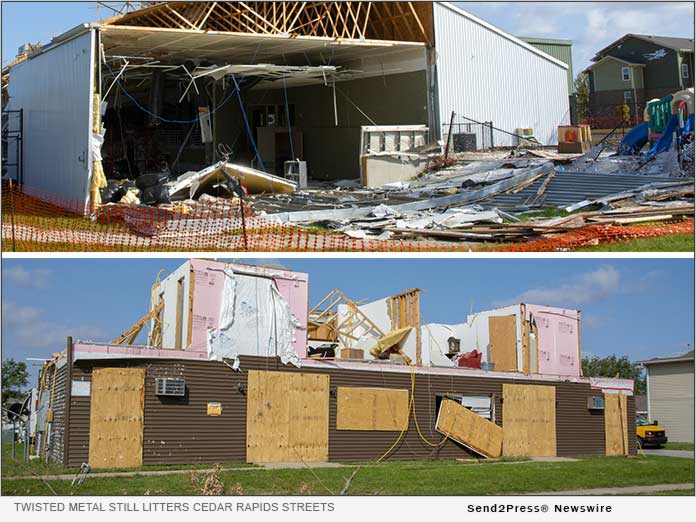DES MOINES and CEDAR RAPIDS, Iowa, Sept. 29, 2020 (SEND2PRESS NEWSWIRE) — One thing Iowans are familiar with is wild weather, says the Iowa Manufactured Homes Association (IMHA). Positioned in the heart of the Midwest, Iowa’s weather ranges from extreme cold and snow to temperatures in the triple digits. And let’s not forget tornadoes. Iowans see virtually everything mother nature can throw, but on August 10, 2020, the state was in for a record-setting weather incident.

PHOTO CAPTION: Laura and Chad Curl rode out the storm, equal to an inland hurricane, in their manufactured home.
What has been compared to an “Inland Hurricane,” a ferocious storm called a derecho swept across the state with winds equal to a Category 2 hurricane, taking down 100-year-old oak trees, stripping homes of roofs, destroying business complexes and more. But through it all, Iowa’s manufactured homes, generally perceived an easy target for wind and storm damage, stood up to the derecho.
“We’re blessed to say the least,” said Troy Hames, General Manager and VP of Sales for Hames Homes. “But, honestly, we’re not surprised.”
Cedar Rapids, Iowa, where Hames manages three manufactured home developments totaling over 900 units, seemed to suffer the worst from Iowa’s derecho. Striking an area with a population of just over 130,000, the damage was overwhelming. Businesses saw structural damage to buildings and signage. Parks and rural areas lost up to 80% of their trees, and thousands of acres of crops will need to be plowed under. Residential areas seemed to fare the worst. Over a month later, many residents are still cleaning up fallen trees and thrown debris. But Hames’ communities, along with other manufactured home communities throughout the state, saw comparatively little damage.
While common perceptions of manufactured homes would lead one to think hurricane force winds would be catastrophic, reality and the recent derecho proved otherwise. Out of Hames’ 900+ units, only three (3) were damaged beyond repair. That’s less than 0.5% destruction. Most units, like the surrounding residential areas on the Southwest side of the city, saw shingles and siding damage. Some external buildings like garages or sheds saw worse, but the homes themselves were safe and secure. Why?
More than old school “Mobile homes,” today’s manufactured homes are subject to strict Federal HUD (Housing and Urban Development) construction guidelines. Based on HUD Code 3280 and 3285(2), “All … manufactured homes built in the U.S. after June 15, 1976 must contain a certification label (commonly referred to as a HUD Tag) on the home. The label is the manufacturer’s certification that the home section is built in accordance with HUD’s Manufactured Home Construction and Safety Standards.”
As it relates to the Midwest Derecho and why the manufactured homes in Iowa fared so well: section 3280.306 (a) on windstorm protection, states, “Each manufactured home shall have provisions for support/anchoring or foundation systems that, when properly designed and installed, will resist overturning and lateral movement (sliding) of the manufactured home as imposed by the respective design loads.”
“This is where we have an advantage over homes built on foundations or even over basements,” said Hames. “HUD requires manufactured homes to have another level of structural integrity – being anchored with galvanized steel straps, at a minimum of four feet into the ground at multiple places on each home.”
Where other construction throughout the area saw devastating damage ranging from missing roofs to complete upper levels destroyed by the derecho, the manufactured homes anchored through their walls and floor joists into the earth saw little impact from winds that reached up to 140 miles per hour and lasted over 20 minutes.

PHOTO CAPTION: Twisted metal and debris still litter Cedar Rapids streets weeks after the August 10th Derecho.
According to a Cedar Rapids Gazette article from August 18, 2020, Lon Pluckhahn, City Manager of Cedar Rapids suburb Marion, Iowa said, “Ninety to 95 percent of all properties in the city sustained some degree of damage.”
As Hames drove through his Summit View development in the southwest corner of Cedar Rapids, he saw the manufactured home community come together to help clean up the damage that did happen. Weeks after the storm, debris from the storm had all but disappeared from the streets of the community, but some units were still waiting on insurance and contractors to finish up minor repair projects.
“These are good, hard-working people,” said Hames. “From first time homebuyers to retirees, we get to see every aspect of the community.”
Chad and Laura Curl, who have been residents in the Summit View development for over 14 years, stopped Troy to give updates on the recovery process for their unit. The Curls property sustained minor roofing damage and cracked siding on the exterior of the home, but nothing more from the derecho. Directly across the street from the development stood a twisted heap of metal girders and splintered wood from a manufacturing plant that didn’t survive the storm.
“Mobile homes have gotten a negative stigma over the years,” said Laura Curl about their development. “Well, I rode a CAT3 hurricane out in mine, and it’s still here,” she continued with a wave of her hand.
The Curls were quick to point out that throughout their manufactured home community, it wasn’t the actual structures that received the brunt of the storm damage, but the ancillary construction – decks, garages, car ports not included in the original structure – that were impacted most.
“We can deal with a little cracked siding,” said Chad Curl. “It’s good to know we have a strong home in a strong community.”
While storms throughout the Midwest come with a litany of risks, the perception that manufactured homes are high risk investments because of these storms just doesn’t hold true. With some models starting as low as the $30,000 range, first-time homebuyers have the advantage of “lower-than-renting” entry points. Others, like empty-nesters or retirees, find many more modern designs with over 2400 square feet of living space, granite countertops, hardwood flooring, all appliances and more.
“These aren’t your grandfather’s mobile homes,” said Hames. “A manufactured home is as safe and secure as most of the houses in the neighborhoods surrounding us, but ours come with community services like snow removal and storm shelters and much less upkeep.”
If you’d like more information on manufactured homes or how you can learn more about the manufactured home industry, you can contact Joe Kelly at the Iowa Manufactured Housing Association, 1400 Dean Avenue, Des Moines, Iowa 50316, visit them on the Web at: https://iamha.org or call 515-265-1497.
The Iowa Manufactured Housing Association (IMHA), established in 1947, is a not-for-profit board made up of elected officials to serve the association members. IMHA represents all segments of the industry: manufacturers of manufactured and modular homes, retailers, community owners, suppliers, and service companies.
More information about IMHA can be found at https://iamha.org.
IMAGE LINKS FOR MEDIA:
[1] https://www.Send2Press.com/300dpi/20-0929s2p-IMHA-CRDestruction-300dpi.jpg
Caption: Twisted metal and debris still litter Cedar Rapids streets weeks after the August 10th Derecho.
[2] https://www.Send2Press.com/300dpi/20-0929s2p-IMHA-Curls-home-300dpi.jpg
Caption: Laura and Chad Curl rode out the storm, equal to an inland hurricane, in their manufactured home.
News Source: Iowa Manufactured Housing Association